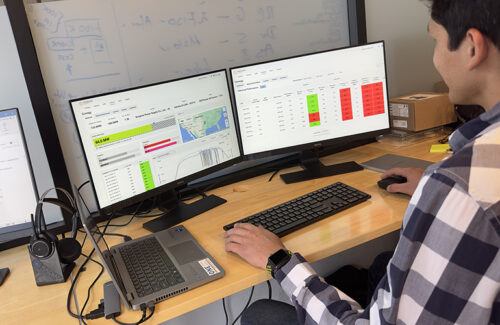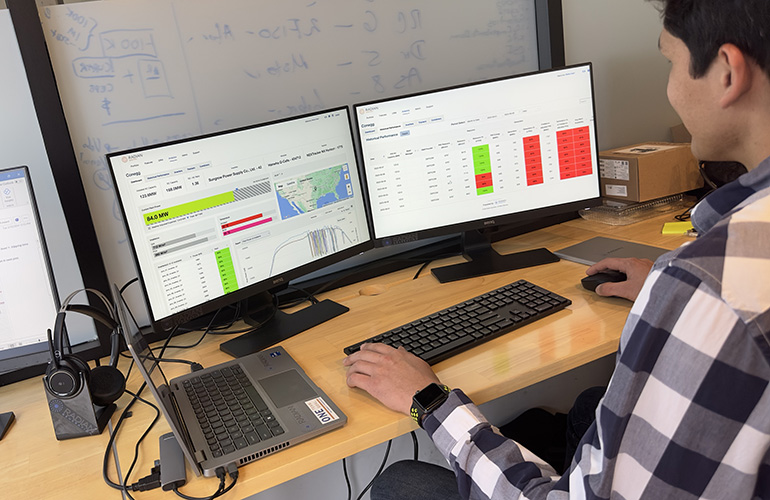 It’s that time of year when solar farm operators face the task of spring maintenance to ensure optimal performance during the long summer days. The consequences of inadequate maintenance can result in lost revenue due to sluggish performance or equipment downtime during peak production periods. Dirt on PV panels reduces the power output. Five grams of dust/m2 can reduce power generation by up to 15%, and 50 grams of dust/m2 can reduce energy loss by 55 to 63%, according to scientific journal Solar Energy. With proper planning and execution of maintenance, these losses can be prevented, ensuring solar farms operate at maximum efficiency during the critical summer months.
It’s that time of year when solar farm operators face the task of spring maintenance to ensure optimal performance during the long summer days. The consequences of inadequate maintenance can result in lost revenue due to sluggish performance or equipment downtime during peak production periods. Dirt on PV panels reduces the power output. Five grams of dust/m2 can reduce power generation by up to 15%, and 50 grams of dust/m2 can reduce energy loss by 55 to 63%, according to scientific journal Solar Energy. With proper planning and execution of maintenance, these losses can be prevented, ensuring solar farms operate at maximum efficiency during the critical summer months.
Successful PV facility maintenance relies on early planning. Industry veterans know that January/February marks the critical starting point for developing comprehensive maintenance strategies. This early start ensures completion by March or April, which is well ahead of peak production months. However, the increasing unpredictability of weather patterns has complicated this timeline. Extended wet periods push maintenance windows later into spring or early summer, while unexpected warm spells can create unforeseen challenges that demand immediate attention.
Going beyond manufacturer recommendations
A common misconception in the industry is that manufacturer-recommended maintenance represents the maximum necessary level of care. Field experience has repeatedly shown this is not the case and should be viewed as a starting point rather than a plan. Each facility faces unique challenges shaped by its geography, equipment configuration and local environmental conditions. Some sites grapple with indigenous insect populations that can wreak havoc on inverters, while others battle aggressive vegetation growth that threatens system efficiency and can interfere with the proper functioning of certain equipment.
Consider the complexity of spring maintenance activities. Aerial scans must be conducted for DC health assessments, with results reviewed and repairs scheduled in a timely manner. Inverters require thorough inspection and cleaning. Vegetation management contractors need to be scheduled before the growth season begins. Panel cleaning assessments should be completed in January and ideally executed by April or May. Panel cleaning needs to be scheduled after vegetation maintenance has been completed. Each of these activities involves multiple stakeholders, specific timing requirements and detailed documentation needs.
Climate change: The new variable
Climate change has significantly impacted traditional maintenance schedules. Extended periods of wet and cold weather pushing further into spring have disrupted conventional maintenance windows, while unexpected severe winter storms and heat waves can stress equipment beyond designed parameters. This new reality requires more flexible and robust maintenance strategies, including:
- Development of a good spare parts strategy to avoid delays in repairs
- Regular inverter inspection, cleaning and maintenance. In some areas cleaning and maintenance may need to go beyond manufacturer’s recommendations.
- Early identification of equipment that performs poorly in excessively warm weather
- Creation of specific strategies with O&M providers to address heat-sensitive equipment
The role of digital asset management
Modern solar farm maintenance requires more than just physical upkeep – it demands sophisticated asset management tools. Software platforms designed specifically for renewable energy enables site operators, owners and asset managers to make data-driven decisions, streamline workflows and track outcomes. For example, Radian Digital software platform can track field services and equipment tickets, and provide a complete history of equipment performance across the fleet, including the business impact and time for repairs, helping with decisions on cost-benefit and preventive maintenance. These tools can also help determine additional actions that may need to be added to the standard maintenance regime.
Key benefits of digital asset management include:
- Automated business impact and loss waterfall reporting to identify downtime trends and inform maintenance planning and spares strategies
- Pre-scheduled and collaborative preventative maintenance tasks, including checklists and document capture
- Workflow management for review, approval and acknowledgement of completed activities
- Systematic tracking of and warranty dates
Essential spring maintenance checklist
 To maximize energy generation, facility operators should prioritize:
To maximize energy generation, facility operators should prioritize:
- Verification that all manufacturer-recommended maintenance is completed before June
- Aerial scans and DC health checks completed as early as possible in the new year, with needed repairs identified in the scans scheduled prior to June
- Implementation and execution of vegetation management plans
- Assessment and execution of panel cleaning needs
- Thorough inverter inspection, cleaning and maintenance
- Evaluation of heat-sensitive equipment
- Development of comprehensive O&M strategies for peak production periods
Looking forward
Whether managing maintenance in-house, through third-party providers or via digital solutions, success depends on expertise in renewable energy systems and the ability to adapt to changing conditions. Analytics and data insights can help facility managers to make informed decisions when performance is suboptimal regardless of plans and schedules.
Remember: Spring maintenance is not just about checking boxes on a maintenance list – it’s about ensuring your solar facility can perform at its peak when it matters most.

